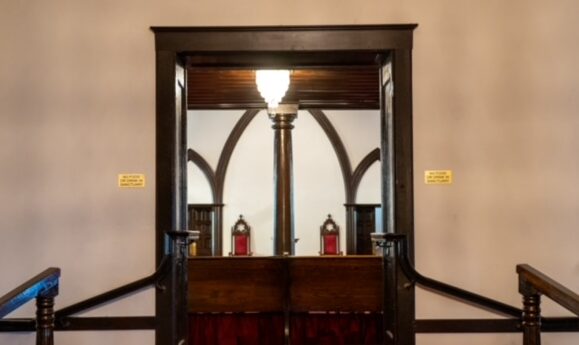
Dedicated to Christ for over 200 years.
Celebrating the faithfulness of God throughout the years.
Early History
EARLY PRESBYTERIANISM IN NORTH ALABAMA (from “A History of the First Presbyterian Church, Florence, Alabama,” written by Doris Kelso in 1968):
“The Tennessee Valley was settled in the main by Scotch-Irish who came in the early part of 1800. It remained for the Presbyterian Church to begin to serve these people. An itinerating system, introduced in 1722, continued to be the home missions system of the church for more than 100 years. Pastors were asked to leave their congregations to take long Home Missionary tours among the Scotch-Irish settlements…. The second phase came from 1815 to the late 1830’s and lasted until the 1840’s. Churches in the North Alabama area, notably Huntsville, Florence, Courtland, and Tuscumbia, were established during the second phase of the missionary tours….”
“The First Presbyterian Church of Huntsville credits Gideon Blackburn with the organization of its congregation on June 15, 1818….It is the Reverend Mr. Blackburn who is named in scattered documents as the organizer of churches in Nashville (1814), in Franklin, Tennessee, in Tuscumbia and in Huntsville, as well as in countless unnamed settlements within a radius of 100 miles of Florence. Gideon Blackburn traveled up and down the valley of the Tennessee (River) for a generation, preaching to whites and Indians alike, in leather stockings, coonskin cap and moccasins, carrying a Bible in one hand and a musket in the other,” according to Alathea Thompson Cobb, as quoted by Kelso. “The first wholly successful work by Presbyterians among the Indians in the South was begun by Blackburn in 1804 when he became missionary to the Cherokees…”
“Blackburn also diligently trained young men for the ministry, including Alexander A. Campbell, who later was the first minister of the Tuscumbia church.”
Campbell had been involved with Cherokee missions, and North Alabama was then part of the Cherokee Nation. He and his wife, Sarah, were close friends of a young Cherokee convert, Catherine Brown, who was trained by Presbyterian missionaries. She went on to become the first Cherokee woman to run a mission school for Cherokee children near her hometown of Creek Path (now Guntersville, AL). She died at age 23 of tuberculosis, with Dr. Campbell serving as her physician in her last months.
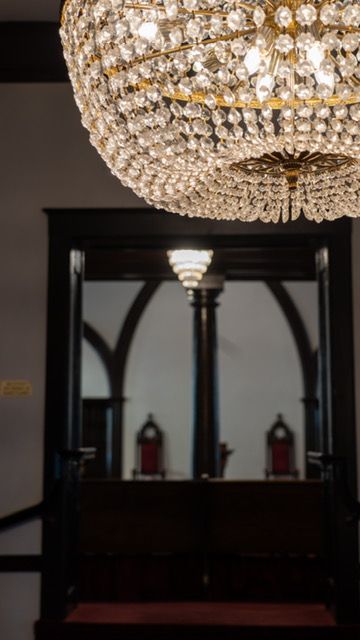
ORGANIZATION OF FRIST PRESBYTERIAN CHURCH, TUSCUMIBA (from “Two Hundred Years at Muscle Shoals,” written by Nina Leftwich in 1926):
“Father Stuart of the Presbyterian Church, who had three missions for the Chickasaw Indians near Pontotoc, Mississippi, established one in this county just inside the Chickasaw Nation west of Caney Creek in 1823. The Franklin Inquirer of March 20, 1824, carried this announcement: ‘The Sacrament of the Lord’s Supper will be administered in the Presbyterian Church of Tuscumbia tomorrow.’ A short history of the church prepared by some of the older members says that on April 18, 1924, a small group of men and women organized the church in the ballroom in what was later known as the Challen House on Spring Hill under the direction of Reverend Blackburn of Frankfort, Kentucky.”
A manual published in Tuscumbia in 1902 notes that Arthur Beatty and James Elliott, both born in Scotland in 1799, were the church’s first Ruling Elders. There were 11 other charter members.
On October 1, 1823, a patent was issued by the United States of America “to Mark R. Cochrell, Assignee of Edwin Hickman of Huntsville, Alabama, according to Holder. “Lot No 288 in the town of Cold Water in the District of Huntsville, State of Alabama, and signed by James Monroe, President, and G.W. Graham, Commissioner of the General Land Office. Mark Cochrell executed a deed to James Elliott, Thomas Limerick and Arthur Beatty, Trustees of the Presbyterian Church in the Town of Tuscumbia, State of Alabama, on the 5th day of June 1827.” The First Presbyterian Church of Tuscumbia was incorporated March 1, 1891.
Notable Church Leaders
Many men have faithfully served the Lord in the pulpit of First Presbyterian.

Gideon Blackburn
1824
Rev. Blackburn was the organizing Pastor of First Presbyterian Church along with “Father Stuart” and the first Lead Pastor, whom he also trained, Alexander Campbell.
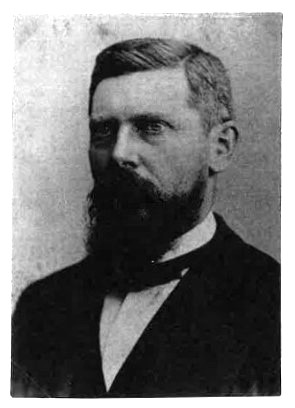
J.G. Lane
1878-1895
Rev. Lane lead the church through the later 1800’s during turmoil and changes in the nation following the Civil War in 1865. His pastorate included the baptism of Helen Keller in 1880.
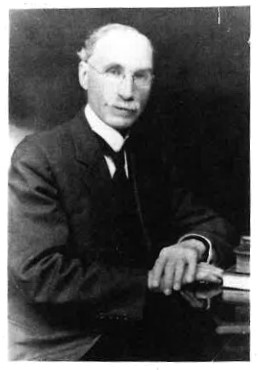
Wilson F. Trump
1903-1926
Rev. Trump came to Tuscumbia from Pensyvainia in 1892 as pricipal for several of the city’s schools. Sensing God’s call to ministry, he was ordained in 1902 and installed as pastor of First Presbyterian in 1903. He died during his pastorate, leaving a legacy of faithfulness and a family heritage in the churc hthat continues to this present day.
Early Church Building
The church building, erected in 1827 and dedicated the following year, stands today essentially as it was 200 years ago and is the oldest original-structure church building in continuous use in Alabama, including during the Civil War. The walls are solid Tuscumbia clay brick in excess of a foot thick. The beams of the almost 30-foot-high ceiling are massive hand-hewn timbers held together with wooden pegs. Iron bars connect the walls of the sanctuary at its apex, placed there to stabilize the walls, due to the effects of a tornado in November of 1874 which damaged the bell tower and moved the church walls about 1.25 inches. That F-4 tornado demolished at least 100 homes in Tuscumbia, which was about one-third of the town. There were at least 14 fatalities.
In the historic, Gothic-style sanctuary, archways and pillars support the wrap-around gallery on three sides. The gallery is accessed by staircases on each side of the vestibule, which opens the auditorium to the street on the front. The original pulpit was nearly the height of the gallery and was accessed by a flight of steps at each end. It was replaced in the 1860’s by the current pulpit, just two steps above the floor. The original, high-back box pews, accessed by a small door, were replaced by the current pews in 1905. These were painstakingly refurbished by professional woodworker and Elder Al Wills, beginning in 2020. The sanctuary was originally fitted with six tall, clear glass windows that were raised and lowered, according to the weather. These were replaced with Italian-made, leaded stained glass memorial windows in 1904. (Explanation of the symbols in the windows begins on page 59 of this history.) A small Session Room for meetings and Sunday School was attached to the east end of the sanctuary, before being replaced by the much-larger annex in 1918. A silver bell, weighing 195 pounds and housed in the belfry, was a gift to the church from the women of Arch Street Presbyterian Church in Philadelphia. It became cracked and was removed in 1891, to be replaced by a 1000-pound bell. While the 130-year-old bell still hangs in the belfry, it can no longer be used. A carillon now provides beautiful bell tones, hymn tunes and chimes that strike the hour and summon the faithful to worship.
First Presbyterian Church of Tuscumbia is Listed on the National Register of Historic Places and is a site on the Alabama Hallelujah Trail for historic places of worship
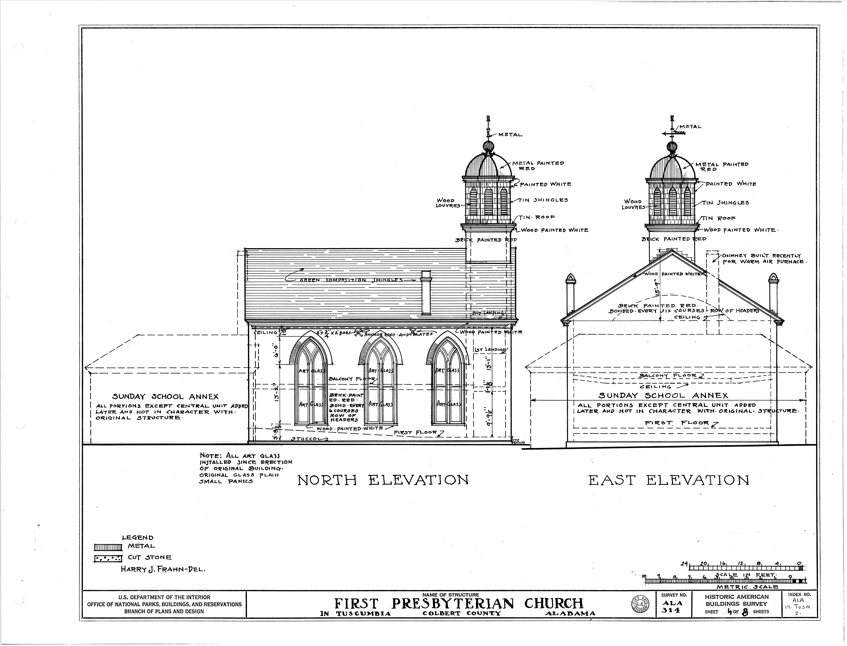
A Full History of the Church
A Full History
First Presbyterian Church of Tuscumbia was likely begun through the efforts of “Father Stuart,” a church planter from Pontotoc, Mississippi, who had encouraged Presbyterian groups throughout the Chickasaw nation. The Church was organized as a “particular church” through the efforts of the prodigious Gideon Blackburn of Frankfurt, Kentucky. Rev. Blackburn was a church planter extraordinaire. From his base of operations in Franklin, Tennessee, he helped organize churches throughout Tennessee and Northern Alabama, including Nashville, Franklin, Huntsville (1818) and Florence (1821). First Presbyterian Church of Tuscumbia was organized on April 13, 1824, with thirteen charter members. It met in the Challen House, an inn overlooking “Big Spring,” now Spring Park in what is now downtown Tuscumbia. Blackburn not only organized the church, but he trained the man who would become its first pastor, Alexander Campbell. The church was united behind the full authority of the Bible as God’s Word and the belief that the Westminster Confession of Faith and Catechisms are an accurate statement of Biblical doctrine. It continues in that great heritage of belief today.
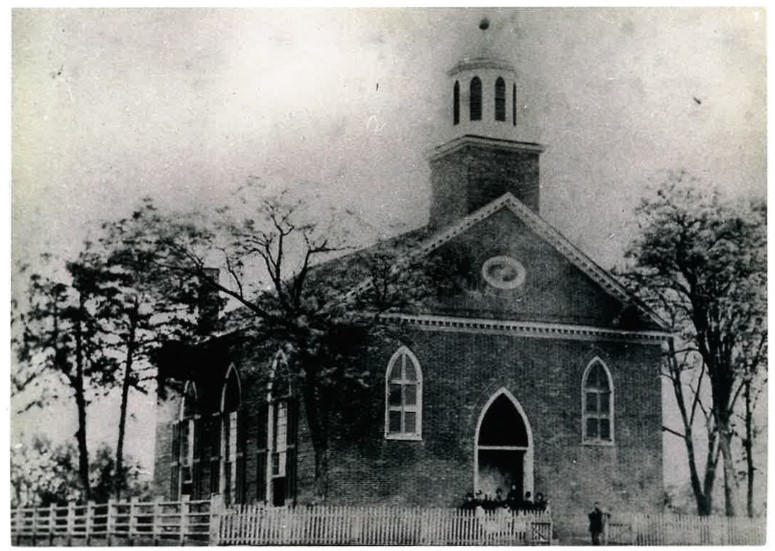
The church was organized in 1824 and is the oldest congregation in Alabama that has met continually.
The church building was erected in 1827 and stands today as the oldest Presbyterian sanctuary in continuous use in Alabama. In one of the entrances of the church there is displayed a copy of the land grant signed by President James Monroe, along with the deed assigned to the church, dated June 5th, 1827. The main building stands essentially as it was over 195 years ago. The walls are solid Tuscumbia clay brick in excess of a foot thick. The ceiling beams are massive hand hewn timbers put together with wooden pegs. Iron bars connect the walls at its apex, placed there due to the effects of a tornado in November of 1874. Its unusual box-like shape and impressive height make it look deceptively smaller from the outside than it is. The sloped sanctuary floor, wrap around gallery, and incredible acoustics make its capacity of nearly 300 an intimate gathering. Changes have occurred to the sanctuary at various times. In the 1860′s the high pulpit, nearly at the height of the gallery, was removed for one just two steps above the floor. The present bell, no longer able to be used but still in place, was installed in 1891. In 1904 the memorial stained glass windows were added. The present pews were added in 1905. In 1922 a four rank organ replaced the earlier reed organ, and a fifteen rank organ was installed in 1989. The church also uses a grand piano, electric piano, and harpsichord in its sanctuary. The original building is essentially the same in structure as it was, except for an annex which replaced the old session room on the east end of the building in 1918. A two story addition was built adjoining the annex in 1962 for fellowship and education. A third story was added in 1983. In 1995 the church launched a four year refurbishing project which, with the help of noted historical consultant Harvie Jones, renovated the sanctuary and annex in period style, giving a greater sense of God’s work down through the years. The finished work displays carpets with rich burgundy hue and much of the original mill work exposed and refinished. Beginning in 2003 the church took on more building projects, updating its office building, creating a new parking lot on the corner of 5th and Broad, and updating the kitchen and fellowship hall. In 2010 the church undertook an extensive shoring up of the original walls, ceiling, and underpinnings of the sanctuary building, complete with special drainage to keep water away from the foundation. In 2015 the church added a new wing in front of the Education building, containing an up to date nursery, a small elevator to the upper floors, a class/meeting room, and, for the first time, full restroom facilities on the same level as the sanctuary. In 2024, in commemoration of its 200th anniversary the church engaged in another extensive brightening up inside and out, especially in the annex of the church. As for our other properties, the “Rowland House,” the former home of an historic church family, is now updated and used as the youth house. The church owns two homes for the use of their pastoral staff. God has been gracious, working through sacrificial giving, able deacons, and gifted decorating committees to make our current facility not only historic, but updated and beautiful.
The church has grown and stayed faithful to the gospel throughout two centuries. In its early years two of its most notable events were the special meetings of Daniel Baker, famous Presbyterian evangelist in 1839 and 1843. As many as one hundred members were added to the church through the first series of meetings. First Presbyterian, along with most other southern Presbyterian churches, left the Presbyterian Church in the United States of America in 1861 to join the Presbyterian Church in the United States, commonly known as the Southern Presbyterian Church. First Presbyterian Church continued, endured, and even grew throughout the next hundred years. In the second half of the 20th century there was increasing concern over the theological decline of the Southern Presbyterian Church. As a result, First Presbyterian left the Presbyterian Church of the United States in 1973. Being careful and judicious, First Church remained independent for several years. The church joined the Presbyterian Church in America in 1988, where it holds membership today. First Presbyterian Church has long been known for its commitment to its Biblical and confessional belief, its lively and strong pulpit ministry, and its deep desire to spread the gospel to all peoples, both here and overseas. It has been responsible for planting two mission churches. The Muscle Shoals Presbyterian Church was started in 1974, and the Redeemer Presbyterian Church of Florence was started with a healthy portion of First Church families in 1999.
The church has held many celebrations of God’s faithfulness in its history. Special booklets outlining the history of church were prepared at the 150th, 175th, and 200th anniversaries. The 200th Bicentennial Celebration on April 20-21, 2024, brought scores of former members and their families back to Tuscumbia. As usual, great meals were a catalyst for joyous fellowship and the sharing of memories. The worship service that Sunday will not soon be forgotten as a record crowd filled the sanctuary with heavenly singing and a genuine sense of God’s presence.
The church has been the grateful recipient of God’s work of grace working in godly leaders. There has been a long line of faithful and effective pastors who have served First Church over the years. Though all of First Presbyterian Church’s 26 senior pastors have been loved and respected, several long and fruitful pastorates have left indelible memories. The ministry of J. O. Steadham (1837-1845) took place during years of growth and revival. B. M. Sawtelle (1861-1872) helped the congregation weather the storm of the Civil War and was beloved for his long and fruitful ministry. W. F. Trump (1903-1926) was revered in the church and in the community. He had come to Tuscumbia in 1892 to become the principal of the local school system. He served in that capacity until his installation as pastor in 1903, having been ordained in 1902. He left not only a legacy of faithfulness, but a family from whom generations of First Presbyterian Church musicians have come. In fact, his daughter, Joy Trump Hamlet, and his granddaughter, Adina Joy Stone, have spearheaded excellence in music known throughout the region. Special holiday concerts, “Great Music Months,” and visits from nationally known composers and performers have been part of the church year for decades. The church office building across the street from the sanctuary was named after Rev. Trump in his memory.
Adrian DeYoung (1942-1950) brought new life into the church after some time of struggle, revitalizing the church with his preaching, energy, and leadership. His widow, Eleanor, returned to Tuscumbia after his death and remained until her passing in 2014. All three of his daughters married Presbyterian pastors. James Patterson (1955-1967) had a long and fruitful pastorate. He was known for his hard work, his pulpit presence, and his love for the people. Ron Siegenthaler (1969-1985) was a strong presence not only of love and care, but of unwavering belief in the truth of Scripture. His long ministry includes the seeds that grew into Covenant Christian School in Tuscumbia. His son Andrew, now pastor in Cullman, Alabama, has graced the pulpit here many times. Andrew is only one of the many “sons of the church” who have gone on to vocational Christian ministry. Albert Sidney Johnson, distinguished Presbyterian minister for over 50 years throughout the south, was likely the best known of many who came from the pew to the pulpit at First Presbyterian Church. Randy Kimbrough, George Robertson, and John Trapp join Andrew Siegenthaler as current Presbyterian pastors who hail from Tuscumbia. In addition, Carol Tune Nantt and her husband Gary have been PCA missionaries in Korea and Mexico and now have returned to the Shoals in retirement. Danny Lynch has spent his life in Christian missions in Africa and now resides with his family in Virginia overseeing missionary efforts in Africa. Joel Linton, who grew up at First Presbyterian, serves as a missionary to Taiwan. Also, former Assistant Pastor Lenden Fleeman serves with his family with Mission to the World (PCA) first in central Asia and now in Barcelona, Spain.
Many wonderful preachers have graced the pulpit of First Presbyterian Church over the years. In addition to the regular pastors, the people have enjoyed the ministry of several visiting ministers. Already mentioned was the great revival preacher Daniel Baker. Others who have come to preach were Presbyterian and Reformed notables such as James Henley Thornwell, William “Bill” Hill, John R. Richardson, Robert Strong, Reed Miller, Robert Rayburn, Robert Reymond, Henry Bast, Henry Krabbendam, Frank Barker, John Sanderson, Ben Haden, Jimmy Lyons, Jim Baird, Paul Kooistra, Harry Reeder, Richard Pratt, and Ligon Duncan.
Several significant families in the life of the Shoals and northern Alabama have been members and officers in First Presbyterian Church. Likely the most famous to those outside of Alabama is the Keller family. Arthur Keller presented his daughter Helen Keller for baptism during the ministry of J. G. Lane in 1880. The Keller family has continued to have officers and leaders in the church down through the years.
There is much more that can be said about the ministry of the church over the years. The church is known for its wonderful Women in the Church Ministry, its missionary commitment, its fine youth programs, and its vital role in the life of the community. The church’s worship has continued in the historic stream of the Presbyterian tradition while also emphasizing joy and enthusiasm. First Presbyterian Church of Tuscumbia continues to be a lighthouse of grace and truth, preaching the same gospel for two hundred years to the glory of God and the joy of its people. 2024
